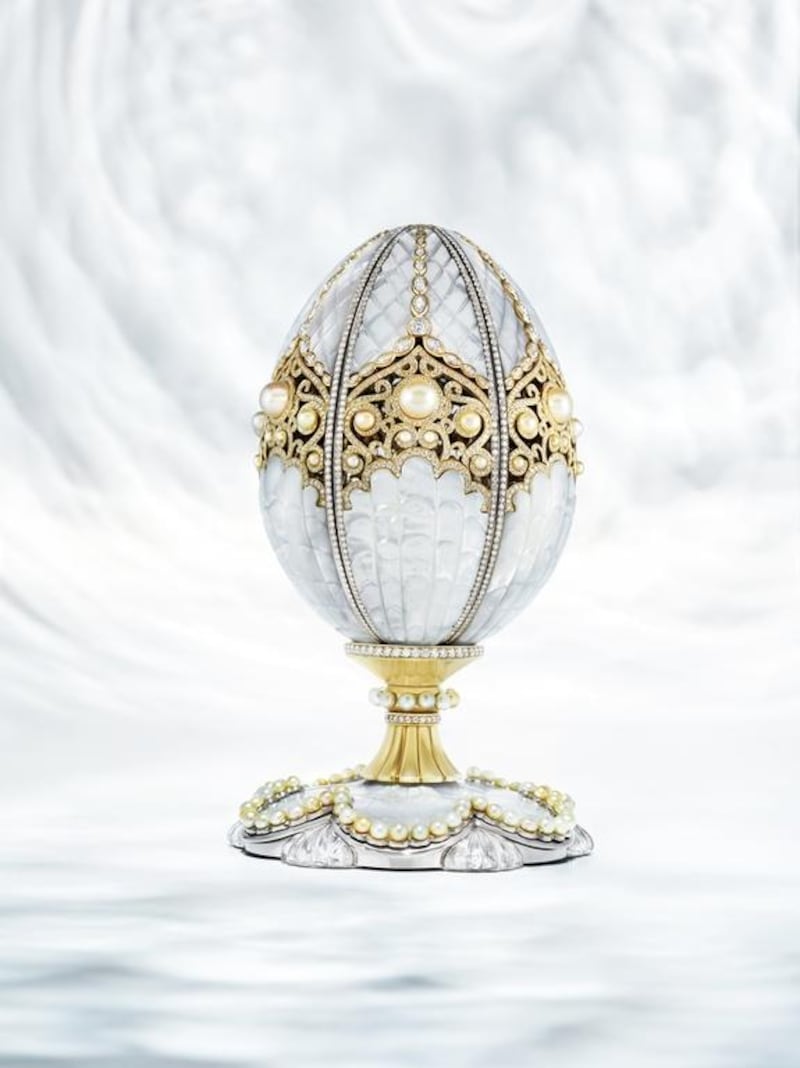For some, the name Fabergé will conjure up images of the exquisite jewels and objets d’art so loved by 19th-century Russian royals; for others, the inexpensive Brut aftershave sported by teenage boys throughout the 1980s and 1990s. It’s an extreme dichotomy, and one that the brand is anxious to address.
The Fabergé story is almost as tumultuous as that of the tsars it so loyally served. The first part of the tale is well documented: Peter Carl Fabergé (pictured above) was born in Russia in 1846 and learnt the art of jewellery-making from his father, a goldsmith. He embarked on a grand tour of Europe as a young man, and returned to his homeland as much inspired by the Medici treasures of Renaissance Florence as by the Baroque jewels of Dresden’s famous Green Vaults. Witty and withering, Fabergé took over the family business in 1882 and went on to become jeweller and goldsmith to the ill-fated Imperial Court. His colourful, artfully crafted creations were coveted by royals, nobility and wealthy industrialists the world over.
In 1885, Fabergé crafted his first Imperial Easter Egg. As the story goes, Tsar Alexander III wanted to surprise his wife, Empress Maria Feodorovna, with a jewelled egg to mark their 20th wedding anniversary. The Hen Egg, which was made of gold and held a series of surprises, started a tradition that would result in the creation of 50 now-famous Fabergé eggs; 42 of these are known to have survived and are to be found in private and museum collections around the world. For an idea of their value, consider that the Winter Egg, which was made in 1913 with an exterior consisting of 1,660 diamonds, was sold at auction in 2002 for an incredible US$9.6 million (Dh35m), and was reportedly bought by the emir of Qatar.
This chapter of the Fabergé story came to an abrupt close with the onset of the Russian Revolution in 1917. The House of Fabergé, so inextricably linked with the ousted royal family, was nationalised and its stock confiscated. Peter Carl Fabergé left Russia on the last diplomatic train out of the country, arriving in Riga and then fleeing to Germany. He died there in 1925 (from a broken heart, according to his family), having never recovered from the shock of these events.
Then came the lost years. In the 1930s, the Fabergé name was used (unbeknownst to the Fabergé family) on a collection of perfumes and toiletries; in 1964, it was sold to the cosmetics company Rayette; in 1989, it was acquired by Unilever for the princely sum of $1.5 billion (Dh5.5bn) and became forever linked with the company’s Brut range of men’s grooming products. It was only in 2007, 90 years after the Bolshevik Revolution, when Fabergé was acquired by the London-based Gemfields, that efforts to restore it to its former glory as a fine-jewellery company began.
I meet the man tasked with spearheading this turnaround, Robert Benvenuto, the president of Fabergé, in Damas’s plush store in The Dubai Mall. A warm, straight-talking, forward-thinking New Yorker, Benvenuto is the first to acknowledge the contradictions that lie at the heart of the brand. “It’s like a start-up, as it hasn’t really been in business for 100 years, and yet the name is so revered. When I was approached for the job, I said: ‘I do not know another company in the hard luxury-goods marketplace in the world that has the same unexploited global growth potential.’ The fact is that we have been handed this name that is already there. You have the engine of a Ferrari sitting in front of you – so let’s build a car around it,” says Benvenuto, who took on his current role at the end of 2013.
The challenge, as with any historic brand, is to stay true to the legacy while remaining relevant. The early post-2007 pieces reveal a slight hesitance – a tendency, perhaps, to rely too heavily on the pre-1917 archives. But not on Benvenuto’s watch. This, it would seem, is yet another new era for the beleaguered brand. “I came in with a fresh pair of eyes,” he says. “You have to understand who you are. You take the best of your history and retranslate. We are avoiding literal translations from the archives. Internally, we have started asking ourselves what Carl Fabergé would do if he were alive today? We know what he did then. He was like the Steve Jobs of his time. But that was then. What would he do today?”
This year has already been a big one for the brand. A century after Peter Carl Fabergé was commissioned to create his last Imperial Egg, the brand has unveiled a new egg, created in collaboration with Qatar’s Al Fardan family, themselves world-renowned pearl collectors. Featuring 139 fine white pearls with a golden lustre, 3,305 diamonds, carved rock crystal and mother-of-pearl set on white and yellow gold, the Fabergé Pearl Egg draws on the idea of a pearl forming within an oyster. The exterior opens to reveal a unique, grey, 12.17-carat pearl sourced from the Arabian Gulf, while an inbuilt mechanism allows the entire outer shell to rotate on its base, while simultaneously opening in six sections to present its hidden treasure.
Complementing the Pearl Egg is a Fabergé necklace made of white pearls, diamonds and mother-of-pearl with a scallop motif, finished with an exquisite 19.44-carat white pearl drop. “I have a passion for natural pearls and it took me many years to build my current collection, gathering some of the most extraordinary pearls in the world. Fabergé has a great history in making jewellery for royalty and a truly precious Fabergé Egg is a luxury treasure and the symbol of a long-gone era of opulence. This is why I partnered with Fabergé to combine these two traditional treasures: the Fabergé Egg and natural Arabian Gulf pearls, to create an exceptional piece,” says Hussain Ibrahim Al Fardan, the chairman of Alfardan Group, who hand-picked each of the pearls featured on the egg from his personal collection.
Also new to the Fabergé portfolio this year are fine-jewellery creations and four new watch collections: a core line called Lady Fabergé; a complication line named Lady Compliquée; a high-jewellery collection, Summer in Provence; and a men’s high-complication range, Visionnaire I.
The idea of surprise and discovery – so fundamental to Peter’s intriguing eggs – is at the core of these new timepieces. The two 38-millimetre pieces in the Lady Compliquée collection pay homage to the Peacock Egg of 1908 and the aforementioned Winter Egg of 1913. In one, a peacock takes up much of the jewel-encrusted dial, and hands are replaced by the bird’s tail feathers, which slowly fan out to mark the passing of the hours; in the other, the dial is gradually covered in frost. Neither offers a particularly practical approach to time-telling, but both are incredibly beautiful.
Meanwhile, Visionnaire I, a flying tourbillon, is designed and produced exclusively by the Swiss watchmaker APRP. With a dial that is divided into seven trapezes, the watch is very much defined by its boldness and masculinity.
But who is the primary Fabergé target audience, now that there are no Russian royals to impress? “The 35- to 55-year-old woman, who is international, accomplished and doesn’t want what everyone else wants. She knows who she is and isn’t defined by what everyone else is wearing,” says Benvenuto.
The ultimate aim is to position Fabergé as the master of coloured stones, he adds. “Three words: the artist jeweller. Fabergé paints with coloured gemstones. Picture an artist’s palette – in this case, rubies, sapphires, emeralds and then some semi-precious stones. Our goal is to create personal pieces of art. I want us to own the precious coloured marketplace. It’s very fragmented, with no clear leader. What Graff is to diamonds, I want us to be for coloured stones.”
With Benvenuto on the case, anything seems possible. This battle-hardened phoenix of a brand may just rise again.
sdenman@thenational.ae






